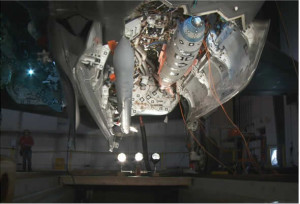

The testing program of the Lockheed Martin F-35 is rapidly progressing toward the weapon testing milestone, which will be significant in validating the new fighter’s combat capabilities for the first time. Among the testing were pit drops conducted at Pax River, and external carriage flights which included aerial refueling for the first time. A major step forward toward the F-35’s warfighting capability was achieved March 29, 2012 at the Naval Air Station at Patuxent River, where the F-35 completed a series of weapon release ground testing, demonstrating release and ejection of weapons configured in nine different combinations inside the F-35s internal weapon bays. Testing included inert versions of the GBU-12 Laser-Guided Bomb, the 1,000-pound GBU-32 Joint Direct Attack Munition and the AIM-120 Advanced Medium-Range Air-to-Air Missile.
The weapons were dropped into a ‘pit drop’ at the base. Weapons pit-drop testing collects data to measure stresses on the airframe and adjacent stores, ensures proper weapon and suspension equipment function, and validates the separation models for the munitions’ ejection characteristics, including trajectories and velocities.
More weapons testing on the F-35B and F-35C carrier variant is ongoing at Naval Air Station Patuxent River. Current test events including pit drops, captive carry and instrumented weapons environmental flights, lead-up to flight separation testing scheduled for later this year. The first and second F-35C test aircraft recently performed formation flights over the Atlantic Ocean test range. F-35C carrier variant of the Joint Strike fighter is distinct from the F-35A and F-35B variants with its larger wing surfaces and reinforced landing gear to withstand catapult launches and deck landing impacts associated with the demanding aircraft carrier environment.

On Saturday, Apr. 21, the conventional takeoff and landing (F-35A) aircraft completed the program’s first in-flight refueling mission while configured with external weapons at Edwards Air Force Base, Calif. On this test flight the F-35A flew with two external inert AIM-9X weapons and four external stores. Internally, the jet was carrying two Joint Direct Attack Munitions and two Advanced Medium-Range Air-to-Air Missiles. The two-hour mission tested the flying qualities of the aircraft while maneuvering with external weapons. These tests are paving the way for weapons separation testing later this year.

















